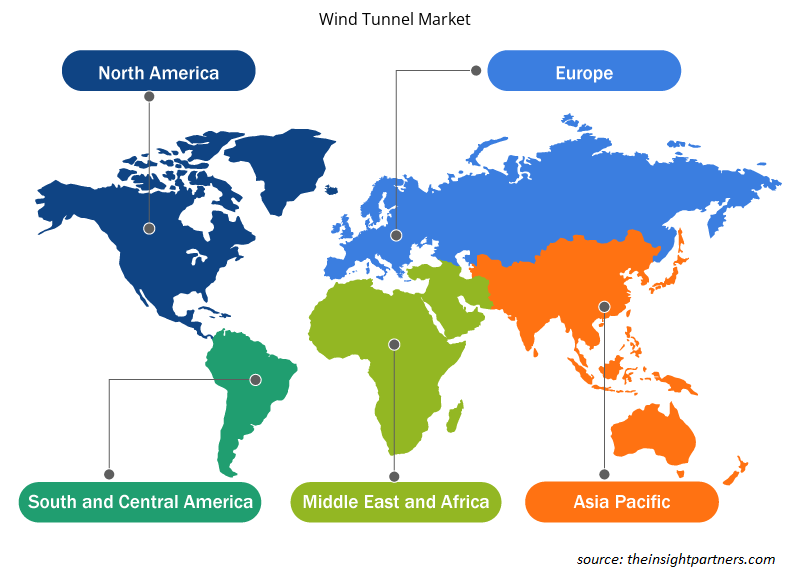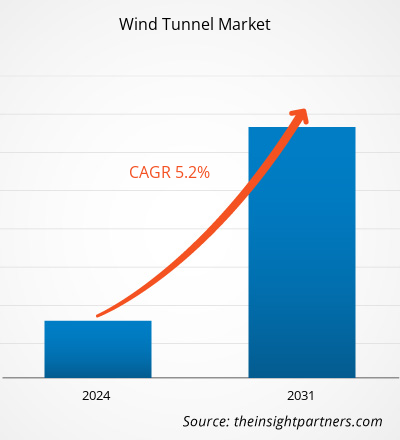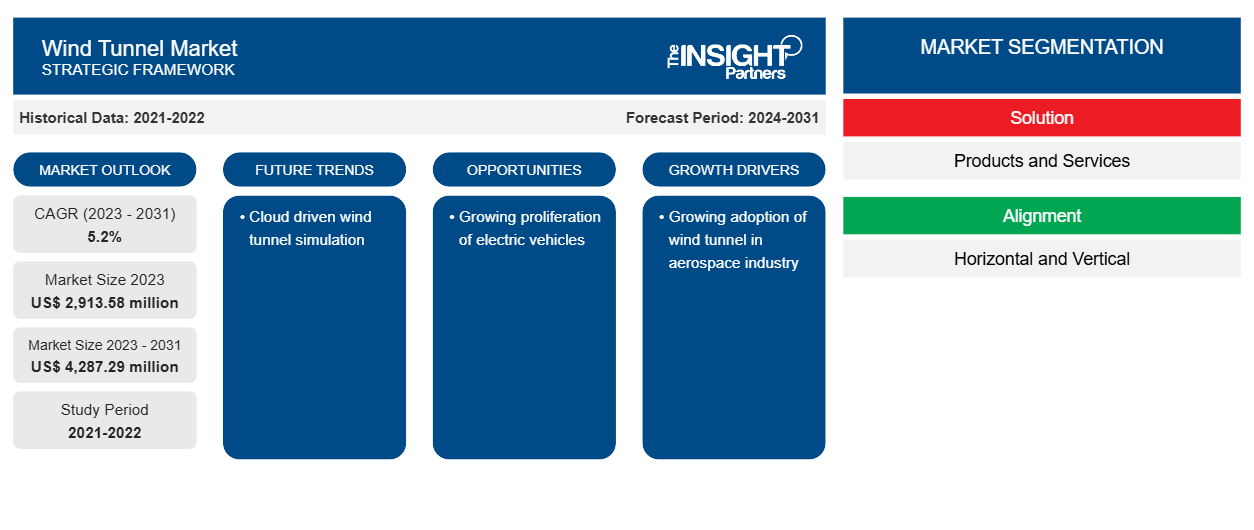Si prevede che la dimensione del mercato delle gallerie del vento raggiungerà i 4.287,29 milioni di dollari entro il 2031, rispetto ai 2.913,58 milioni di dollari del 2023. Si prevede che il mercato registrerà un CAGR del 5,2% nel periodo 2023-2031. È probabile che lo sviluppo crescente nel settore delle costruzioni rimanga una tendenza chiave nel mercato.CAGR of 5.2% during 2023–2031. The growing development in the construction sector is likely to remain a key trend in the market.
Analisi di mercato della galleria del vento
Si prevede che i crescenti investimenti dei governi per rafforzare le capacità di produzione nei paesi in via di sviluppo e gli aggiornamenti dei servizi di manutenzione, insieme ai progressi nella tecnologia delle strutture di prova, stimoleranno la domanda di gallerie del vento tra le industrie di utilizzo finale nei prossimi anni. Gli utenti finali delle gallerie del vento sono industrie su larga scala, come l'automotive e l'aerospaziale, che influenzano direttamente le dinamiche di mercato. Attualmente, il settore dei veicoli elettrici nell'automotive e i settori di produzione di UAV e velivoli/missili da difesa nell'aerospaziale stanno guidando la crescita del mercato.UAV and defense aircraft/missile manufacturing sectors in aerospace are driving the growth of the market.
Panoramica del mercato delle gallerie del vento
Si prevede che la crescente domanda di infrastrutture verdi e la crescente adozione di veicoli elettrici stimoleranno la domanda per il mercato delle gallerie del vento a livello globale. La crescente applicazione delle gallerie del vento nel settore aerospaziale sta alimentando la crescita del mercato delle gallerie del vento a livello globale. Al mercato sono associati costi elevati e sfide operative, che potrebbero ostacolare la crescita. Tuttavia, si prevede che la crescente proliferazione di simulazioni di gallerie del vento basate sul cloud guiderà la crescita del mercato delle gallerie del vento a livello globale.
Personalizza questo report in base alle tue esigenze
Riceverai la personalizzazione gratuita di qualsiasi report, comprese parti di questo report, o analisi a livello nazionale, pacchetto dati Excel, oltre a usufruire di grandi offerte e sconti per start-up e università
-
Scopri le principali tendenze di mercato in questo rapporto.Questo campione GRATUITO includerà analisi di dati che spaziano dalle tendenze di mercato alle stime e alle previsioni.
Driver e opportunità del mercato delle gallerie del vento
Crescente proliferazione di edifici ecologici per favorire il mercato
Si prevede che la crescente enfasi sugli approcci ecosostenibili e rispettosi dell'ambiente nel settore delle costruzioni stimolerà la crescita del mercato delle gallerie del vento a livello globale. La galleria del vento può identificare la velocità del vento attorno alla superficie dell'edificio. L'impatto della forza del vento sull'edificio è cruciale, in particolare negli edifici alti con ampie superfici esposte al vento, in cui la struttura interna dell'edificio resiste alle forze risultanti. Nonostante la crescente adozione della fluidodinamica computazionale per i test strutturali grazie a un calcolo più veloce, non è considerata adatta per l'uso di routine nella progettazione strutturale degli edifici, poiché le sue previsioni devono essere verificate tramite esperimenti. La valutazione dell'impatto della forza del vento su edifici alti , fabbriche e ponti può aiutare i progettisti di edifici a costruire una struttura che resista in modo efficiente agli effetti del vento. Pertanto, la crescente proliferazione del mercato dell'edilizia verde sta stimolando la crescita del mercato delle gallerie del vento.
Crescente domanda di veicoli elettrici
L'aerodinamica mostra un ruolo importante nelle auto elettriche rispetto ai veicoli basati su ICE, poiché il massimo utilizzo di energia per accelerare o guidare in salita può essere recuperato tramite recupero di energia. Per gestire le esigenze di recupero di energia, gli ingegneri automobilistici eseguono un'analisi aerodinamica di un'auto elettrica per passeggeri utilizzando gallerie del vento. Le gallerie del vento eseguono i test aerodinamici primari di un veicolo elettrico. Si prevede che la crescente enfasi sulla mitigazione dell'inquinamento ambientale e la crescente tendenza all'adozione di veicoli elettrici per passeggeri offriranno opportunità positive per il mercato delle gallerie del vento.
Analisi della segmentazione del rapporto di mercato della galleria del vento
I segmenti chiave che hanno contribuito alla derivazione dell'analisi di mercato della galleria del vento sono la soluzione, l'allineamento,tipo di velocità e applicazione.
- In base alla soluzione, il mercato delle gallerie del vento è suddiviso in prodotti e servizi. Il segmento dei servizi ha detenuto una quota di mercato maggiore nel 2023.
- Per allineamento, il mercato è segmentato in orizzontale e verticale. Il segmento orizzontale ha detenuto una quota di mercato maggiore nel 2023.
- In termini di tipo di velocità, il mercato è diviso in subsonico, supersonico, transonico e ipersonico. Il segmento subsonico ha detenuto una quota significativa del mercato nel 2023.
- In termini di applicazione, il mercato è segmentato in aerospaziale e difesa, automotive e trasporti, edilizia ed energia eolica, formazione e simulazione, sport d'avventura, paracadutismo e altri. Il segmento aerospaziale e difesa ha detenuto una quota significativa del mercato nel 2023.
Analisi della quota di mercato delle gallerie del vento per area geografica
L'ambito geografico del rapporto sul mercato delle gallerie del vento è suddiviso principalmente in cinque regioni: Nord America, Asia Pacifico, Europa, Medio Oriente e Africa, Sud e Centro America.
L'Europa è leader di mercato. La crescente applicazione delle gallerie del vento nel settore aerospaziale e della difesa sta stimolando la crescita del mercato delle gallerie del vento in Europa. Esistono vari tipi di gallerie del vento, ciascuna con le proprie caratteristiche e intervallo di velocità. I centri di ricerca e i laboratori per la costruzione e la progettazione di aeromobili stanno sfruttando molto le gallerie del vento. Inoltre, la crescente applicazione delle gallerie del vento subsoniche nel settore aerospaziale sta avendo un impatto positivo anche sulla crescita del mercato delle gallerie del vento nella regione. L'elevata presenza di prodotti e fornitori di servizi per gallerie del vento nella regione sta anche agendo come un importante motore per il mercato delle gallerie del vento in Europa.
Approfondimenti regionali sul mercato delle gallerie del vento
Le tendenze regionali e i fattori che influenzano il mercato delle gallerie del vento durante il periodo di previsione sono stati ampiamente spiegati dagli analisti di Insight Partners. Questa sezione discute anche i segmenti e la geografia del mercato delle gallerie del vento in Nord America, Europa, Asia Pacifico, Medio Oriente e Africa e America meridionale e centrale.

- Ottieni i dati specifici regionali per il mercato delle gallerie del vento
Ambito del rapporto di mercato sulle gallerie del vento
| Attributo del report | Dettagli |
|---|---|
| Dimensioni del mercato nel 2023 | 2.913,58 milioni di dollari USA |
| Dimensioni del mercato entro il 2031 | 4.287,29 milioni di dollari USA |
| CAGR globale (2023-2031) | 5,2% |
| Dati storici | 2021-2022 |
| Periodo di previsione | 2024-2031 |
| Segmenti coperti |
Per soluzione
|
| Regioni e Paesi coperti |
America del Nord
|
| Leader di mercato e profili aziendali chiave |
|
Densità degli attori del mercato: comprendere il suo impatto sulle dinamiche aziendali
Il mercato del Wind Tunnel Market sta crescendo rapidamente, spinto dalla crescente domanda degli utenti finali dovuta a fattori quali l'evoluzione delle preferenze dei consumatori, i progressi tecnologici e una maggiore consapevolezza dei vantaggi del prodotto. Con l'aumento della domanda, le aziende stanno ampliando le loro offerte, innovando per soddisfare le esigenze dei consumatori e capitalizzando sulle tendenze emergenti, il che alimenta ulteriormente la crescita del mercato.
La densità degli operatori di mercato si riferisce alla distribuzione di aziende o società che operano in un particolare mercato o settore. Indica quanti concorrenti (operatori di mercato) sono presenti in un dato spazio di mercato in relazione alle sue dimensioni o al valore di mercato totale.
Le principali aziende che operano nel mercato delle gallerie del vento sono:
- Laboratorio aeronautico
- Aiolo
- La compagnia Boeing
- ETW GmbH
- Horiba Ltd
- Società per azioni Lockheed Martin
Disclaimer : le aziende elencate sopra non sono classificate secondo un ordine particolare.

- Ottieni la panoramica dei principali attori del mercato delle gallerie del vento
Notizie e sviluppi recenti sul mercato delle gallerie del vento
Il mercato delle gallerie del vento viene valutato raccogliendo dati qualitativi e quantitativi dopo la ricerca primaria e secondaria, che include importanti pubblicazioni aziendali, dati associativi e database. Di seguito sono elencati alcuni degli sviluppi nel mercato delle gallerie del vento:
- La galleria del vento climatica MAHLE "diventa elettrica". MAHLE amplia la gamma di servizi presso la struttura all'avanguardia di Stoccarda e consente di testare gli effetti della ricarica rapida su batterie agli ioni di litio sensibili in un'ampia gamma di possibili condizioni climatiche. (Fonte: MAHLE Group, comunicato stampa, febbraio 2023)
- L'Università di Notre Dame e la Lockheed Martin Corporation hanno firmato un Master Research Agreement il 4 novembre 2021, per facilitare future collaborazioni che facciano progredire la ricerca aerospaziale. Questo accordo dimostra il desiderio reciproco di entrambe le istituzioni di accelerare la loro relazione produttiva in corso. (Fonte: Lockheed Martin Corporation, comunicato stampa, novembre 2021)
Copertura e risultati del rapporto sul mercato delle gallerie del vento
Il rapporto “Dimensioni e previsioni del mercato delle gallerie del vento (2021-2031)” fornisce un’analisi dettagliata del mercato che copre le seguenti aree:
- Dimensioni e previsioni del mercato delle gallerie del vento a livello globale, regionale e nazionale per tutti i segmenti di mercato chiave coperti dall'ambito
- Tendenze del mercato delle gallerie del vento e dinamiche di mercato come driver, vincoli e opportunità chiave
- Analisi PEST e SWOT dettagliate
- Analisi di mercato della galleria del vento che copre le principali tendenze del mercato, il quadro globale e regionale, i principali attori, le normative e i recenti sviluppi del mercato
- Analisi del panorama industriale e della concorrenza che copre la concentrazione del mercato, l'analisi della mappa di calore, i principali attori e gli sviluppi recenti per il mercato della galleria del vento
- Profili aziendali dettagliati
- Analisi storica (2 anni), anno base, previsione (7 anni) con CAGR
- Analisi PEST e SWOT
- Valore/volume delle dimensioni del mercato - Globale, Regionale, Nazionale
- Industria e panorama competitivo
- Set di dati Excel
Report recenti
Rapporti correlati
Testimonianze
Motivo dell'acquisto
- Processo decisionale informato
- Comprensione delle dinamiche di mercato
- Analisi competitiva
- Analisi dei clienti
- Previsioni di mercato
- Mitigazione del rischio
- Pianificazione strategica
- Giustificazione degli investimenti
- Identificazione dei mercati emergenti
- Miglioramento delle strategie di marketing
- Aumento dell'efficienza operativa
- Allineamento alle tendenze normative























 Ottieni un campione gratuito per - Mercato delle gallerie del vento
Ottieni un campione gratuito per - Mercato delle gallerie del vento